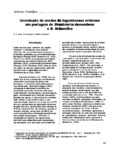Use este identificador para citar ou linkar para este item:
http://www.alice.cnptia.embrapa.br/alice/handle/doc/597239| Título: | Introdução de mudas de leguminosas arbóreas em pastagem de Brachiaria decumbens e B. brizantha. |
| Autoria: | DIAS, P. F.  SOUTO, S. M.   FRANCO, A. A.   |
| Afiliação: | Paulo Francisco Dias, PESAGRO-Rio/EES; Sebastião Manhães Souto, Embrapa Agrobiologia; Avílio Antônio Franco, Embrapa Agrobiologia. |
| Ano de publicação: | 2007 |
| Referência: | Pasturas tropicales, Cali, v. 29, n. 1, p. 59-66, abr. 2007. |
| Conteúdo: | En un Latossolo Vermelho-Amarelo, en Itatiaia-RJ, Brasil, se evaluaron el desarrollo y la sobrevivencia de plantas de las especies arbustivas siguientes, establecidas con y sin protección en pasturas de Brachiaria decumbens y B. brizantha en pastoreo: 1- Gliricidia (Gliricidia sepium), 2- Albizia (Pseudomanea guachapele), 3- Mulungu (Erythrina verna), 4- Jurema Preta (Mimosa tenuiflora), 5- Sabia (Mimosa caesalpiniifolia), 6- Angico Vermelho (Anadenanthera macrocarpa), 7- Olosericia (Acacia holosericea), 8- Acacia Auriculada (Acacia auriculiformis), 9- Jurema Branca (Mimosa anemisiana), 10- Orelha de Negro (Enterolobium contortisiliquum), 11- Guapuruvu (Schizolobium parahyba), 12- Mulungu do Alto (Erythrina poeppigiana), 13- Coração de Negro (Albizia lebbeck), 14- Leucena (Leucaena leucocephala), 15- Jacaranda Bico de Pato (Machaerium hirlum), 16- Canafistula (Peltophorum dubium). Los resultados mostraron que, Leucena y Gliricidia tuvieron um pobre desarrollo cuando fueron plantadas sin protección contra el consumo por los animales. Por el contrario, Jurema Preta mostro uma alta tolerância al dano por animales em pastoreo. The introduction of unprotected young plants of 16 leguminous tree species into Brachiaria decumbens and B. brizantha pastures under grazing was evaluated in four different moments of the year at the Itatiaia Municipality, RJ. Two variables related to plant height and number of sproutings were used for the evaluations. These variables were correlated (r= 0,92; p< 0.0001). The nil hypothesis was rejected by the four Manova tests, thus the results of this experiment were analysed by means of multidimensional variance analysis in order to better explore the combined information of the variables. The statistical difference of the means by the Scott-Knott test of the 64 treatments of the principal canonical variable, suggested the formation of four groups with the Jurema Preta (Mimosa tenuiflora) group standing out at the 4th evaluation. Difference among treatments means for each variable, calculated by Bonferroni confidence intervals, revealed that the greatest plant height and the highest number of sproutings were found for Jurema Preta. The results related to the variables with grazing obtained from Jurema Preta confirm its recommendation for the region as the tree legume with the highest chances of growth whether introduced into pastures under grazing without protection. |
| Thesagro: | Brachiaria Decumbens Brachiaria Brizantha Pastagem |
| NAL Thesaurus: | pastures |
| Notas: | Parceria: PESAGRO. |
| Tipo do material: | Artigo de periódico |
| Acesso: | openAccess |
| Aparece nas coleções: | Artigo em periódico indexado (CNPAB)  |
Arquivos associados a este item:
| Arquivo | Descrição | Tamanho | Formato | |
|---|---|---|---|---|
| Introducaodemudasdeleguminosasarboreas.pdf | 145,25 kB | Adobe PDF |  Visualizar/Abrir |









